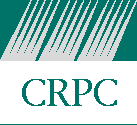
Ken Kennedy
Director
Linda Torczon
Executive Director
Danny Powell
Associate Director,
Business
CRPC Sites and Executive
Committee Members
Argonne National Laboratory
Rick Stevens
California Institute
of Technology
Mani Chandy
Herbert B. Keller
Dan Meiron
Paul Messina
Los Alamos
National Laboratory
Andrew White
Rice University
(Headquarters)
John E. Dennis, Jr.
Ken Kennedy
Richard Tapia
Linda Torczon
Syracuse University
Geoffrey Fox
University of Tennessee
Jack Dongarra
University of Texas
Mary F. Wheeler
CRPC Affiliated Sites
Boston University
Drexel University
Indiana University
Institute for
Computer Applications in
Science and Engineering
University of Illinois
University of Maryland
|
Information on the Center for Research
on Parallel Computation (CRPC) |
Rice University
CRPC - MS 41
6100 Main Street
Houston, Texas 77005
713-348-6077 |
For more information, contact
Danny Powell
713-348-6011 or danny@rice.edu |
|
What is the CRPC? What is its main goal?
The CRPC is a National Science Foundation Science and Technology Center established in 1989 to make massively parallel computing systems as usable as conventional sequential computing systems are today.
|
What institutions make up the CRPC?
The CRPC is a consortium of researchers at seven sites: Argonne National Laboratory (IL), Caltech (Pasadena, CA), Los Alamos National Laboratory (NM), Rice University (Houston, TX), Syracuse University (NY), the University of Tennessee at Knoxville, and the University of Texas in Austin. There are also six affiliated sites at Boston University, Drexel University (Philadelphia, PA), Indiana University, the Institute for Computer Applications in Science and Engineering, or ICASE (Hampton, VA), the University of Maryland-College Park, and the University of Illinois at Urbana-Champaign.
|
What is parallel computing?
Parallel computing takes hundreds or thousands of microprocessors (the "brains" behind computers) and makes them work in parallel on a single computing task. These microprocessors can be linked together in a single computer or can be housed separately in computers that are linked together on a network.
|
What has the CRPC accomplished?
Since 1989, the CRPC has:
- Fulfilled its mission to make parallel computers truly usable by fostering advances in software and algorithms;
- Supported development of standards for machine-independent programming interfaces, such as Parallel Virtual Machine (PVM) and Message-Passing Interface (MPI);
- Conducted research leading to widely-used, advanced languages like High Performance Fortran (HPF), Concurrent C++ (CC++), and Fortran M;
- Developed new algorithms needed to use parallel computers effectively fostering physical simulation, numerical optimization, and linear algebra;
- Enabled American businesses to more accurately and quickly test and design new products, analyze information in exploring for oil and gas, clean up the environment, manage health care, and schedule airline crews;
- Pioneered new methods for distributing and packaging algorithm technology;
- Managed software distribution for the entire Federal High Performance Computing and Communications (HPCC) program (the National HPCC Software Exchange, or NHSE);
- Initiated and implemented graduate programs and coursework in computational science at Syracuse University, Rice University, Caltech, and the University of Tennessee, and
- Trained and encouraged more than 700 teachers and 750 students -- especially underrepresented minorities and women -- to pursue or interest students in mathematics and science careers.
|
What are the CRPC's plans for the future?
In upcoming years, the center plans to fulfill a new mission, that of making computational problem-solving truly accessible. In accomplishing this mission, the center will broaden the base of scientists and engineers capable of solving sophisticated computational problems by developing radically new software and systems.
|
How will the CRPC collaborate with other occupants of the new Computational Science and Engineering (CSE) building and with the larger community?
- Through the newly formed Houston Area Computational Science Consortium (HACSC), the CRPC will collaborate with CS/CAAM and other researchers at Rice University, University of Houston, and Baylor College of Medicine, using the Very High Speed Backbone Network Service, or vBNS. This recently funded very broad bandwidth connection will provide a valuable tool to many computationally intensive research projects, enabling them to conduct research that would otherwise not be possible, and ultimately connecting them to the top networked research resources in the country.
- The CRPC-established degree program in Computational Science and Engineering at Rice University will continue to draw upon multi-departmental resources. The program was featured in a National Research Council report as a model of interdisciplinary educational programs to be emulated and will continue to serve as a model for many similar programs around the country.
- Collaboration among the departments will foster CRPC-initiated educational programs, which encourage underrepresented minorities and women to pursue computational science and engineering careers. These programs, which are being emulated nationwide, have encouraged hundreds of students and teachers to collaborate with the CRPC on an ongoing basis.
- Collaboration between CRPC-funded faculty members and other faculty in the new building will facilitate computational engineering optimization work and the transfer of new developments into industrial applications.
- The resources of the new building will strengthen existing and future CRPC associations in the larger community with international visitors, industry representatives, world-renowned researchers and educators, members of national consortia, and those involved in national partnerships to advance the nation's computational infrastructure.
|
Related URLs
- The Center for Research on Parallel Computation (CRPC)
- http://www.crpc.rice.edu/CRPC/
- Ken Kennedy, CRPC Director
- http://www.cs.rice.edu/~ken/
- Kathy El-Messidi, CRPC Associate Director for External Relations
- http://www.cs.rice.edu/~elmessy/ (elmessy@cs.rice.edu)
- CRPC Leadership
- http://www.crpc.rice.edu/CRPC/generalInfo/leadership.html
- CRPC Sites
- http://www.crpc.rice.edu/CRPC/generalInfo/FAQ.html#Sites
- The National Science Foundation
- http://www.nsf.gov/
- NSF Science and Technology Centers
- http://www.graphics.cornell.edu/allstc/
|

